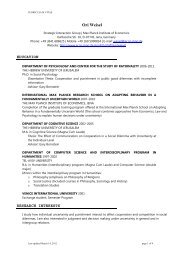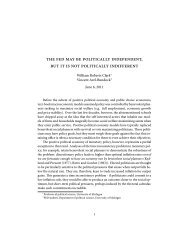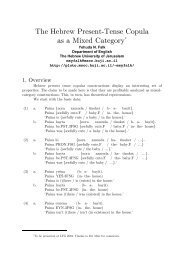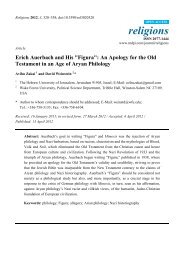Transitive verbs with non-accusative alternation in ... - Pluto Huji Ac Il
Transitive verbs with non-accusative alternation in ... - Pluto Huji Ac Il
Transitive verbs with non-accusative alternation in ... - Pluto Huji Ac Il
You also want an ePaper? Increase the reach of your titles
YUMPU automatically turns print PDFs into web optimized ePapers that Google loves.
80<br />
Rivka Halevy<br />
Yet, it is my contention that the above discussed properties of transitivity<br />
have to be understood relative to a prior understand<strong>in</strong>g of the two<br />
alternative construals as holistic units, the Gestalt of which does not simply<br />
emerge from the summation of their constituent parts.<br />
My work<strong>in</strong>g hypothesis – <strong>in</strong> l<strong>in</strong>e <strong>with</strong> a basic assumption of cognitive<br />
l<strong>in</strong>guistics, and of construction grammar <strong>in</strong> particular – is that the<br />
availability of the alternat<strong>in</strong>g ways of envisag<strong>in</strong>g the scene does not depend<br />
on the referential category of the NP, nor on the semantic class of the verb,<br />
but h<strong>in</strong>ges upon the abstract, schematic mean<strong>in</strong>g of the construction frame,<br />
very much as is the case for the Ø/a transitivity <strong>alternation</strong> <strong>in</strong> Spanish<br />
(Delbecque 1999a, 1999b, 2002). In other words, the Hebrew ‘et/be<strong>alternation</strong><br />
also corresponds to two different construction frames, each one<br />
represent<strong>in</strong>g a different ground<strong>in</strong>g of the O <strong>in</strong> a cognitive doma<strong>in</strong>.<br />
The <strong>accusative</strong>, ‘et-construal depicts a unidirectional relationship. In this<br />
prototypically transitive configuration, the A plays the role of a typical<br />
agent, while the O plays the converse role, namely that of a typical patient<br />
or causee. The event is viewed as an effective transfer of energy from the<br />
A (Source) to the O (Goal), <strong>in</strong> terms of reach<strong>in</strong>g a goal, viz., of caus<strong>in</strong>g a<br />
change of state <strong>in</strong> the O by transferr<strong>in</strong>g energy to it. While the focus of the<br />
scene is on the A, the O, be<strong>in</strong>g semantically and syntactically bounded to<br />
the doma<strong>in</strong> of the verb, is conceptualized as part of the background. In<br />
Langackerian terms, it thus ma<strong>in</strong>ta<strong>in</strong>s a low profile.<br />
On the other hand, along the l<strong>in</strong>es suggested by Delbecque (2002), the<br />
prepositional configuration marks the causal relationship between the A<br />
entity and the O entity as “bilateral”: viz., the two participants play a<br />
salient and <strong>non</strong>-arbitrary role <strong>in</strong> the scene, there is more to them than just<br />
the overt prototypical roles of Source and Goal. The preposition signals the<br />
relevance of the reference doma<strong>in</strong> of the O entity, which represents an<br />
<strong>in</strong>dependent argument not bounded by the verbal predication. In other<br />
words, be- <strong>in</strong>sertion highlights the conceptual autonomy of the O entity<br />
<strong>with</strong> respect to the predicate; <strong>in</strong> terms of sett<strong>in</strong>g up the participants of the<br />
scene, it gives the O a high profile and turns the spotlight on it. To quote<br />
Delbecque (2002: 87) on the ‘prepositional <strong>accusative</strong> a <strong>alternation</strong>’ <strong>in</strong><br />
Spanish: “a functions as a compensat<strong>in</strong>g mechanism for a form-mean<strong>in</strong>g<br />
contradiction, viz., it restores the equilibrium between the S entity and the<br />
DO entity by re-enhanc<strong>in</strong>g the DO’s actantial value.”<br />
The prepositional frame yields the conceptualization of an oriented and<br />
progressive event, <strong>in</strong> which both the A entity and the O entity are “actively”<br />
and simultaneously <strong>in</strong>volved. There is no implication of an accidental event<br />
here. The presence of be- suggests concern on the part of the O entity.<br />
Unlike what happens <strong>in</strong> “bl<strong>in</strong>d” action, the O role is not reduced to that of a



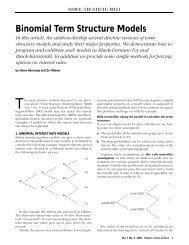
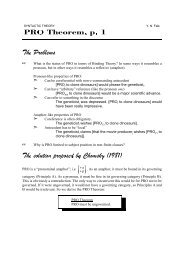
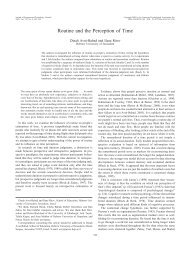
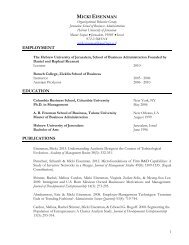
![CV [PDF] - Pluto Huji Ac Il](https://img.yumpu.com/18174585/1/190x245/cv-pdf-pluto-huji-ac-il.jpg?quality=85)

